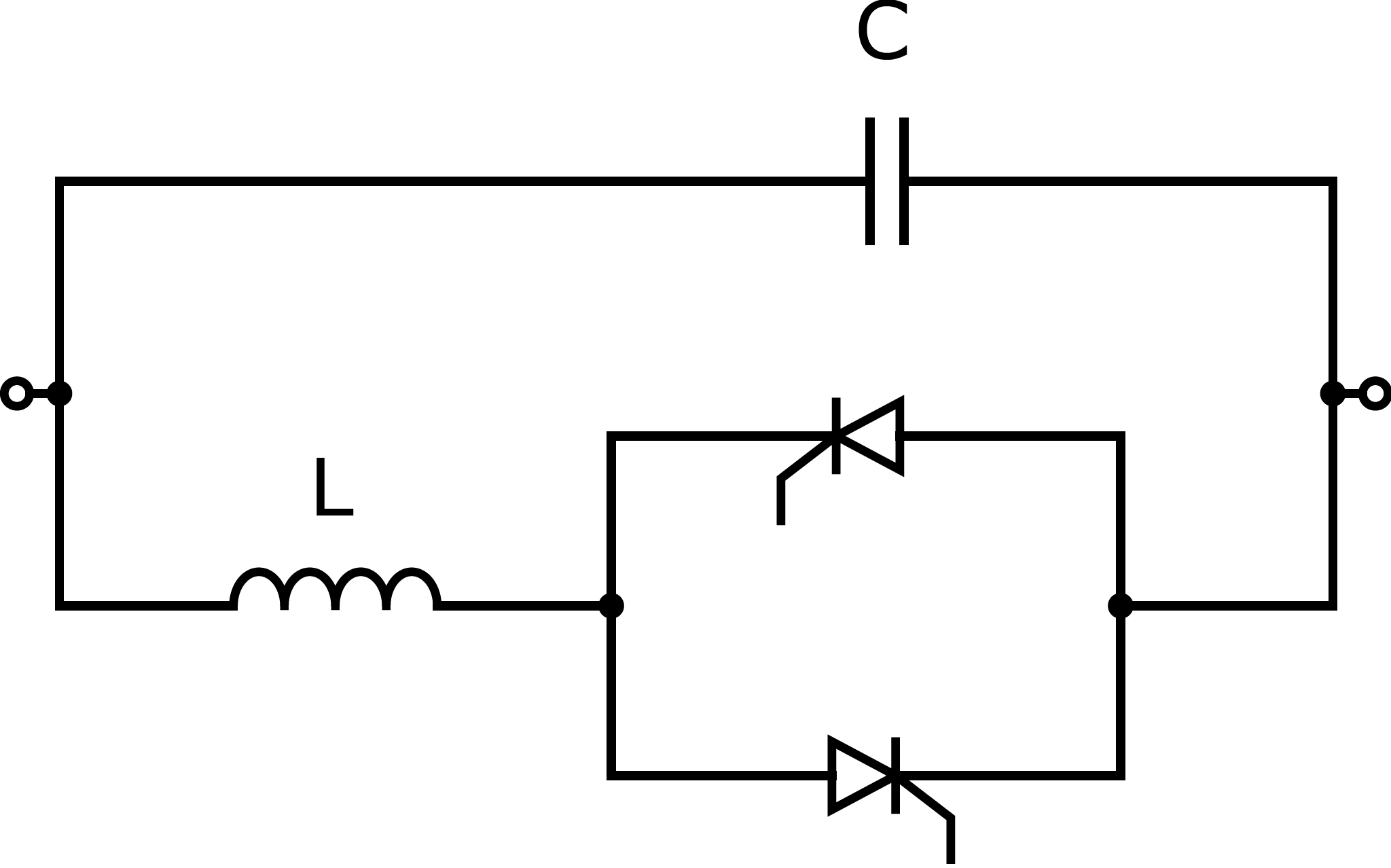Thyristor-Controlled Series Capacitor (TCSC)
We implement the FACTS devices based on the following source:
A. Panosyan, “Modeling of advanced power transmission system controllers”, Ph.D. dissertation, Gottfried Wilhelm Leibniz Universität Hannover, 2010.
Thyristor-Controlled Series Capacitor (TCSC) device is a series element that controles the power flowing through its path by regulating its impedance. The TCSC device is very similar to the Static Var Compensator (SVC) - in fact, it is its series counterpart. Indeed, a TCSC device consists of a parallel circuit of a fixed capacitor and a reactor controlled by a pair of antiparallel thyristors. In contrast to SVC, a TCSC device is connected in series in the power system. For more context, be advised to read the documentation for the SVC elements:
See also
See also
We demonstrate the use-case of this device in the pandapower tutorial: FACTS.
Create Function
- pandapower.create.create_tcsc(net, from_bus, to_bus, x_l_ohm, x_cvar_ohm, set_p_to_mw, thyristor_firing_angle_degree, name=None, controllable=True, in_service=True, index=None, min_angle_degree=90, max_angle_degree=180, **kwargs)
Creates a TCSC element - series impedance compensator to control series reactance. The TCSC device allows controlling the active power flow throgh the path it is connected in.
Multiple TCSC elements in net are possible. Unfortunately, TCSC is not implemented for the case when multiple TCSC elements have the same from_bus or the same to_bus.
Note: in the Newton-Raphson power flow calculation, the initial voltage vector is adjusted slightly if the initial voltage at the from bus is the same as at the to_bus to avoid some terms in J (for TCSC) becoming zero.
min_angle_degree, max_angle_degree are placehowlders (ignored in the Newton-Raphson power flow at the moment).
- INPUT:
net (pandapowerNet) - The pandapower network in which the element is created
from_bus (int) - starting bus of the tcsc
to_bus (int) - ending bus of the tcsc
x_l_ohm (float) - impedance of the reactor component of tcsc
x_cvar_ohm (float) - impedance of the fixed capacitor component of tcsc
set_p_to_mw (float) - set-point for the branch active power at the to_bus
- thyristor_firing_angle_degree (float) - the value of thyristor firing angle of tcsc (is used directly if
controllable==False, otherwise is the starting point in the Newton-Raphson calculation)
- OPTIONAL:
name (list of strs, None) - element name
- controllable (bool, True) - whether the element is considered as actively controlling
or as a fixed series impedance
in_service (bool, True) - True for in_service or False for out of service
- index (int, None) - Force a specified ID if it is available. If None, the
index one higher than the highest already existing index is selected.
min_angle_degree (float, 90) - minimum value of the thyristor_firing_angle_degree
max_angle_degree (float, 180) - maximum value of the thyristor_firing_angle_degree
- OUTPUT:
index (int) - The unique ID of the created tcsc
Input Parameters
net.tcsc
Parameter |
Datatype |
Value Range |
Explanation |
name |
string |
name of the TCSC |
|
from_bus* |
integer |
index of the from bus where the TCSC is connected |
|
to_bus* |
integer |
index of the to bus where the TCSC is connected |
|
x_l_ohm* |
float |
\(\geq\) 0 |
impedance of the reactor component of TCSC |
x_cvar_ohm* |
float |
\(\leq\) 0 |
impedance of the fixed capacitor component of TCSC |
set_p_to_mw* |
float |
set-point for the power flowing through the TCSC element at the to bus |
|
thyristor_firing_angle_degree* |
float |
:math:90 leq 180 |
the value of thyristor firing angle of TCSC |
controllable* |
boolean |
True / False |
whether the element is considered as actively controlling or as a fixed series impedance |
in_service* |
boolean |
True / False |
specifies if the TCSC is in service. |
min_angle_degree |
float |
\(\geq\) 90 |
minimum value of the thyristor_firing_angle_degree |
max_angle_degree |
float |
\(\leq\) 180 |
maximum value of the thyristor_firing_angle_degree |
*necessary for executing a power flow calculation.
Electric Model

The series impedance \(X_{TCSC}\) of the TCSC element is calculated equivalently to SVC, according to the following equation:
The term \(X_L\) stands for the reactance of the reactor (x_l_ohm) and the term \(X_{Cvar}\) stands for the total capacitance (x_cvar_ohm). The thyristor firing angle \(\alpha\) is the state variable that on the one hand defines the impedance of the element, and at the same time is the result of the Newton-Raphson calculation. The admittance \(Y_{TCSC}\) equals \(-1j \frac{1}{X_{TCSC}}\).
The power flow through the TCSC element is described by the following equation:
Result Parameters
net.res_tcsc
Parameter |
Datatype |
Explanation |
thyristor_firing_angle_degree* |
float |
the resulting value of thyristor firing angle of svc [degree] |
x_ohm |
float |
resulting value of the shunt impedance of svc [Ohm] |
q_mvar |
float |
shunt reactive power consumption of svc [MVAr] |
vm_pu |
float |
voltage magnitude at svc bus [pu] |
va_degree |
float |
voltage angle at svc bus [degree] |